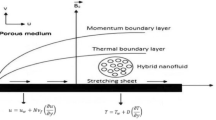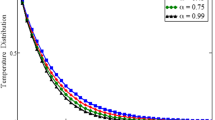Abstract
This study introduced a lattice Boltzmann computational scheme capable of modeling thermo hydrodynamic flows with simpler equilibrium particle distribution function compared with other models. The equilibrium particle distribution function is the local Maxwelian equilibrium function in this model, with all the constants uniquely determined. The characteristics of the proposed model is verified by calculation of the sound speeds, and the shock tube problem. In the lattice Boltzmann method,a thermal fluid or compressible fluid model simulates the reflection of a weak shock wave colliding with a sharp wedge having various angles θw. Theoretical results using LBM are satisfactory compared with the experimental result or the TVD.
Similar content being viewed by others
Abbreviations
- c :
-
Particle velocity
- c s :
-
Sound speed
- e :
-
Internal energy
- f σi (t,r) :
-
Particle distribution function onr att
- P :
-
Pressure
- R :
-
Radius of curvature
- R* :
-
Gas constant
- r :
-
Lattice node
- T :
-
Absolute temperature
- t :
-
Time
- u a :
-
Fluid velocity
- γ :
-
Coefficient of specific heats
- ɛ :
-
Knudsen number
- X :
-
Thermal conductivity
- λ :
-
Second viscosity
- μ :
-
Viscosity
- ρ :
-
Density
- σ :
-
Number of speeds of particles
- τ :
-
Time increment
- φ :
-
Relaxation parameter
- Ω :
-
Collision operator
- αβγ:
-
Cartesian coordinate
References
Alexander, F. J., Chen, S. and Sterling, D. J., 1993, “Lattice Boltzmann thermodynamics,” Physical Review E, Vol.47, pp. 2249–2252.
Chen, H., Chen, S. and Matthaeus, W. H., 1992, “Recovery of the Navier-Stokes Equations Using a Lattice-Gas Boltzmann Method,” Physical Review A, Vol. 45, pp. R5339–5342.
Chen, Y., Ohashi, H. and Akiyama, M., 1994, “Thermal Lattice Bhatnagar Gross Krook Model without Nonlinear Deviations in Macrodynamic Equations,” Physical Review E, Vol. 50, pp. 2776–2783.
Cornubert, R., d’Humiere, D. and Levermoer, D., 1991, “A Knudsen layer theory for lattice gases,” Physica D, Vol. 47, pp. 241–259.
Frisch, U., Hasslacher, B. and Pomeau, Y., 1986, “Lattice-Gas Automata for the Navier- Stokes Equation,” Physical Review Letters, Vol. 55, pp. 1505–1508.
Gabic, B. D., 1992, “Shock Wave Reflection Phenomena,” Springer Verlag.
McNamara, G. and Zannetti, G., 1988, “Use of the Boltzmann Equation to Simulate Lattice Gas Automata,” Physical Review Letters, Vol. 61, pp. 2332–2335.
Qain, Y. H., D’Humieres, D. and Lallemand, P., 1992, “Lattice BGK. models for Navier-Stokes Equation,” Europhysis Letters, Vol. 17, pp. 479–484.
Rothman, D. H. and Zaleski, S., 1997, “Lattice-Gas Celluar Automata-Simple Models of Complex Hydrodynamics,” Cambridge University Press.
Sasoh, A., Takayama, K. and Saito, T., 1992, “A weak shock wave reflection over wedge,” Shock Waves 2, pp. 277–281.
Tsutahara, M. and Kang, H. K., 2002, “A Discrete Effect of the Thermal Lattice BGK Model,” Journal of Statistical Physics, Vol. 107, No. 112, pp. 479–498.c s
Wolf-Gladrow, D. A., 2000, “Lattice-gas Cel- lular Automata and Lattice Boltzmann Models,” Lecture Notes in Mathematics, Springer.M s
Author information
Authors and Affiliations
Corresponding author
Rights and permissions
About this article
Cite this article
Kang, HK., Tsutahara, M., Ro, KD. et al. Numerical analysis of a weak shock wave propagating in a medium using lattice boltzmann method (LBM). KSME International Journal 17, 2034–2041 (2003). https://doi.org/10.1007/BF02982444
Received:
Revised:
Published:
Issue Date:
DOI: https://doi.org/10.1007/BF02982444




